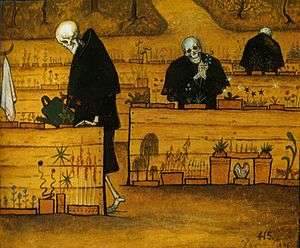The Garden of Death
 | |
| Artist | Hugo Simberg |
|---|---|
| Year | 1896 |
| Type | Watercolor and gouache |
| Dimensions | 16 cm × 17 cm (6.3 in × 6.7 in) |
| Location | Ateneum, Helsinki |
The Garden of Death (Finnish: Kuoleman puutarha) (1896) is a painting by Finnish symbolist painter Hugo Simberg. Like many of Simberg's paintings, it depicts a gloomy, otherworldly scene. The central figures are reminiscent of the classic black-clad Grim Reaper, but paradoxically are tending to gardens; traditionally symbols of birth or renewal.
The Garden of Death is one of the few paintings whose symbolism Simberg explained; typically he preferred to let viewers come to their own conclusions. In a note on one sketch he described the garden as "the place where the dead end up before going to Heaven". [1][2] Simberg's juxtaposition of the traditionally frightening imagery of death with the tenderness and humor of his portrayal invite the viewer to consider mortality in a new light. [3]
The painting was a favourite subject of Simberg's and he made several versions using different techniques, including larger fresco version of the painting in the Tampere Cathedral, which also contains other works by Simberg.

References
- ↑ (Finnish) Hugo Simberg at YLE.fi
- ↑ The Garden of Death at New York University's Art, Literature and Medicine Database
- ↑ The History, Art and Architecture of Tampere Cathedral
